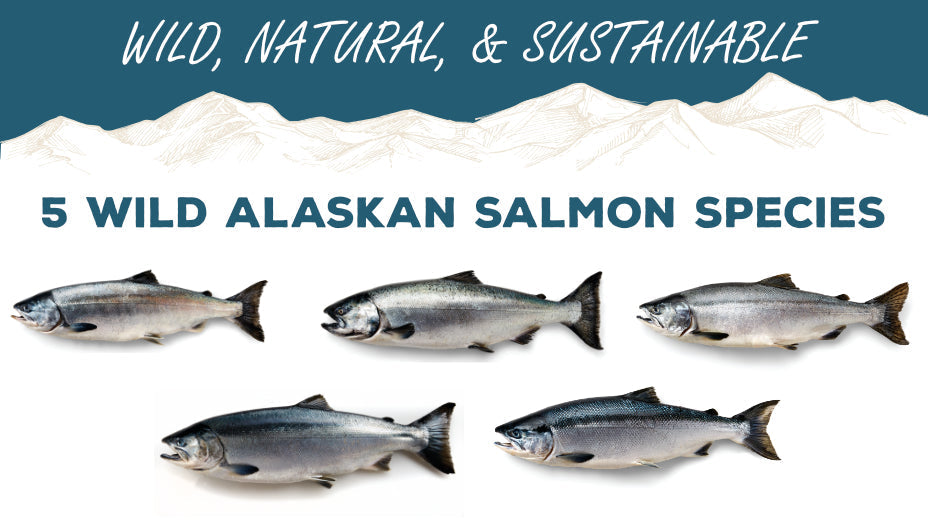The Five Wild Alaskan Salmon Species
We are wild about salmon—and for good reason. Few foods carry such a perfect balance of flavor, nutrition, and story. From the icy waters of Alaska come five distinct species of wild salmon: King, Sockeye, Coho, Keta, and Pink. Each one has its own taste, texture, and nutrient profile, making it possible for just about everyone to find a favorite.
At Wild for Salmon, we’re proud to offer all five species—wild-caught, sustainable, and as pure as the waters they swim in. To help you discover which salmon best suits your palate, we’ve created this simple guide.
Why These Salmon Are Special
-
Cuts & Portions – The salmon pictured here are all center cuts, but when you order, you’ll receive a natural mix of collars, center cuts, and tails. Sockeye and Keta are available in both fillets and portions. (A fillet is a whole side, averaging 1.5 lbs; portions are cut pieces from that fillet.)
-
Color Variations – The vivid hues of salmon flesh come from their natural diet. Because our fish are 100% wild and free of additives, colors vary beautifully from piece to piece.
-
Pin Bones – For Sockeye and Keta, we mechanically remove the pin bones with a 98% success rate (a stray bone may remain). King, Coho, and Pink arrive with all their naturally occurring bones intact.
-
Omega-3 Fatty Acids – All salmon species are rich in omega-3s, but some shine even brighter. We’ve noted which are the highest, making it easier to choose based on your health goals.
-
Nicknames & Common Names – Don’t be confused:
-
Sockeye = Red Salmon
-
Coho = Silver Salmon
-
Keta = Chum Salmon
-
King = Chinook Salmon
-
Pink = Humpback Salmon
-
No matter the name, they all come from the same wild Alaskan waters.
Meet the Five Wild Alaskan Salmon Species
King Salmon (Chinook)
-
Flavor & Texture: Rich, buttery, and luxurious with the highest oil content of all five.
-
Nutrition: Packed with omega-3s and vitamin D.
-
Best For: Grilling, searing, or special occasions when you want salmon to feel like a centerpiece.
Sockeye Salmon (Red)
-
Flavor & Texture: Bold, deep flavor with a firm, ruby-red flesh.
-
Nutrition: High in omega-3s and prized for its color and intensity.
-
Best For: Grilled fillets, baked portions, or recipes where you want salmon’s flavor to stand out.
Coho Salmon (Silver)
-
Flavor & Texture: Mild, delicate, and slightly sweet, with a medium firmness.
-
Nutrition: Leaner than King or Sockeye but still a strong source of omega-3s.
-
Best For: Roasting, pan-searing, or family meals where a versatile salmon shines.
Keta Salmon (Chum)
-
Flavor & Texture: Mild and subtle, with a lighter color and lower oil content.
-
Nutrition: A leaner option, but still a great source of protein and omega-3s.
-
Best For: Smoking, marinating, or pairing with bold sauces and seasonings.
Pink Salmon (Humpback)
-
Flavor & Texture: Light, delicate flavor with soft, pale flesh.
-
Nutrition: Lower in fat but still nutrient-rich.
-
Best For: Quick cooking methods, canned salmon recipes, or lighter meals.
Choosing Your Salmon
Whether you’re looking for the buttery decadence of King, the bold ruby richness of Sockeye, or the approachable delicacy of Pink, there’s a salmon for every taste and every table.
At Wild for Salmon, we believe that exploring all five is part of the adventure—discovering the subtle differences in flavor, color, and texture is as joyful as the meal itself.
And remember: no matter the species, you’re choosing sustainably caught, nutrient-dense, wild Alaskan salmon—good for your body, and good for the planet.




